By Patricia Lee
Water is vital for life; ecosystems depend on it and it plays an essential role in balancing the climate. As a resource for productive activity, water has a political and economic value, and it is one of the most unique and remarkable elements of planet Earth. A colourless, odourless and tasteless liquid, it covers about 70% of the planet’s surface, and along with energy, carbon, nutrients and oxygen, it is one of the building blocks of life.
Organisms need water for making energy and disposing of waste. It nourishes entire ecosystems, maintaining healthy rivers, creeks and wetlands on which the world population depends. It covers basic needs such as drinking and personal hygiene, and it is used for a wide variety of purposes such as food production, manufacturing goods and activities related to waste management, energy production and transport. The significance of water as part of social and economic development make the need for sustainable management of water resources and education for water sustainability imperative.
Ensuring sustainable access to safe drinking water and sanitation are critical steps towards achieving sustainable water management. The implementation of policies and regulations is important to develop capable technologies to provide higher health and development standards.
This article aims to provide the reader with a background to the scientific findings on water systems and water sustainability in the 21st Century. Following the introduction, the key factors that have impacted water systems and the need for a new approach to water resources management will be briefly discussed. Lastly, this article will explore the necessary shift in social values and discuss the requirement of an integrated framework for the development of improved sustainable water management. Earth’s Water in the 21st CenturyIn a world that faces unprecedented pressure on water resources and where global population growth has been projected to reach the 10 billion mark by 2050 (DESA, 2019), water remains at the centre of economic and social development. Access to water and sanitation is a fundamental human right covering the availability, accessibility, quality and safety, acceptability and affordability of this essential resource. Over 80 states have recognised the right to water and sanitation along with the right to life, the right to health and the right to a safe environment (UN, 2010). Still, concerns about extreme weather events, water scarcity, climate change and water security are challenging the world’s ability to allocate, regulate and conserve water resources. When considering the United Nations Sustainable Goals adopted in 2015, access to safe drinking water and sanitation is central to eradicate poverty, achieve gender equality, reduce child mortality, increase education and achieve environmental sustainability. Strains on water supplies can pose a serious challenge to sustainable development, economic equity and political and social stability.
The essentiality of water is embodied by its capacity to serve as a link between geophysical, socio-ecological and economic systems that together comprise a global water system[1] (Bogardi, 2013). The availability of water varies from time to time depending on natural processes, water distribution and storage. Water flows through Earth’s oceans, atmosphere and land consistently via the water cycle, the water’s natural way of self-recycling. Freshwater sources increase continuously, but the supply remains constant as the cycle returns water to Earth; however, it is not always returned to the same location, and its quantity and quality are changed during the cycle. Hence, water conservation is critical for the sustainable management of the natural resource of freshwater (See figure 1).
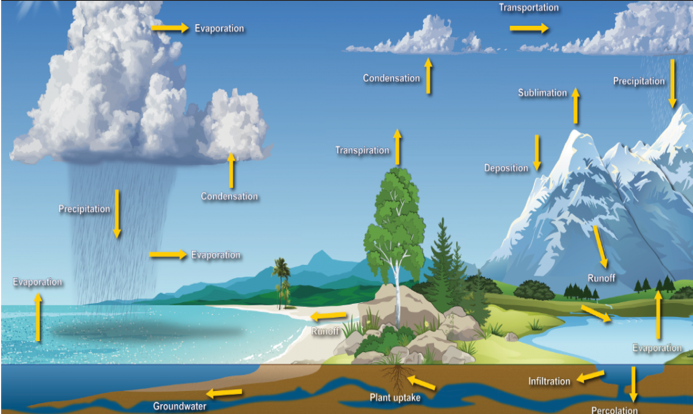
In the 21st Century, the world is experiencing unprecedented pressure on water resources derived from new social, environmental and economic challenges that risk planetary sustainability. Water is threatened directly by factors like climate change, rapid population growth, urbanisation, higher consumption levels and overdevelopment (UN, 2018). Moreover, flaws in its regulation and extraction, land-use change and the lack of integrated global management of water resources, represent a risk for water availability.
The scale and speed of Earth’s changes during and after the Industrial Revolution are evidence that the natural variability of its components has changed. The growing and unregulated use of fossil fuels impacts air, water, soil and habitats causing higher levels of pollution and uncontrolled exploitation of resources.
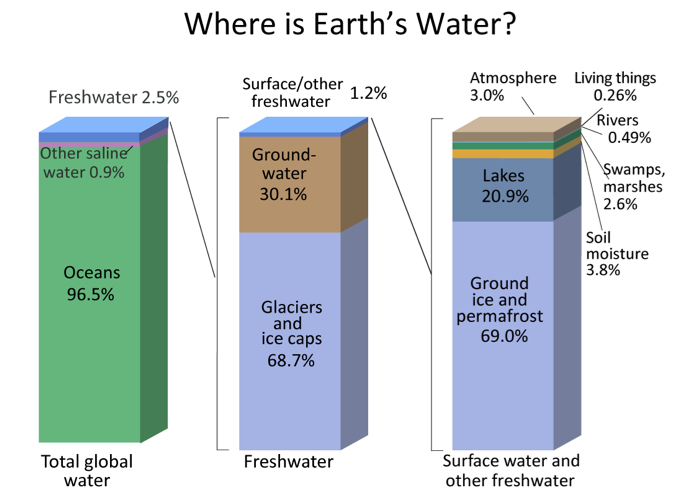
Other water issues such as water-use efficiency, water quality monitoring and wastewater management need to be recognised and undertaken through a coherent global framework to meet the development goals. Furthermore, promoting the concept of water security could help improve water use efficiency increasing water productivity. UNESCO (2015) defines water security as:
“The capacity of a population to safeguard access to adequate quantities of water of acceptable quality for sustaining human and ecosystem health on a watershed basis, and to ensure efficient protection of life and property against water-related hazards – floods, landslides, land subsidence, and droughts.” (2015, p.3).
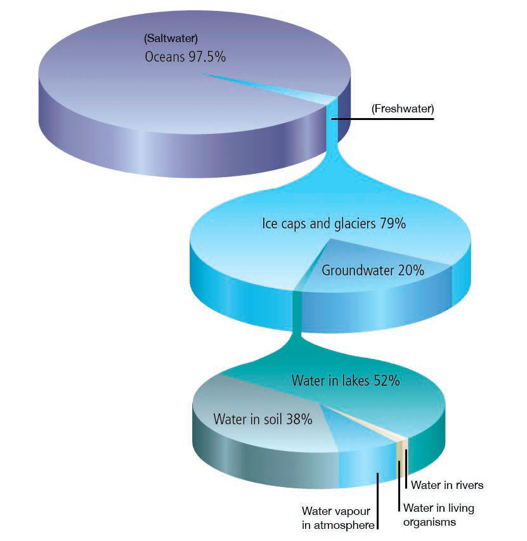
Future efficient environmental technologies could enable societies to reduce their impacts, enabling adaptation, improving their resource productivity, water quality, and preserving water providing ecosystem (UN, 2015). Efforts to promote investment in new technologies should be an essential feature of water sustainability goals. Moreover, as Mai-Lan Ha (2015) has suggested, the skills and expertise of societal actors such as technicians, scientists, engineers and managers are crucial in ensuring sustainable developing technologies are implemented.
Population Growth and Climate Change The world’s population of nearly 7.7 billion is expected to increase rapidly. Data from the latest United Nations Population Division (2019), projects that the global population could grow to 9.7 billion by 2050 and reach 11 billion by the end of the Century. Demographic history shows that surges of population growth are mostly temporary, and as shown in the UN latest report (2019), rapid population growth will come to a halt. However, even if fertility rates continue to decline, it would not slow future population growth.
Climate change and an increasing population are impacting global water consumption with a higher demand for domestic, industrial and agricultural processes. Science has proven that, to a certain extent, climate change has accelerated due to an increase in greenhouse gases related to human activities (Elshemy 2013, IPCC 2018, UN 2018). The International Panel on Climate Change (2015) has stated that Earth’s average temperature is warming and that anthropogenic factors (originated due to human activity) are responsible for it. Additionally, the impacts of climate change on freshwater systems from precipitation variability and intensity, to the warming of lakes and rivers and the increasing forms of water pollution have been growing in magnitude and length.
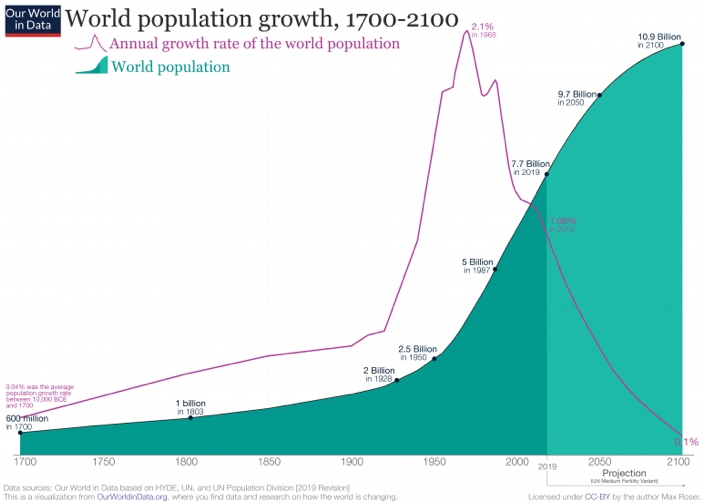
The World Bank (2019) states that 2.2 billion people still lack access to safely managed drinking water services, and 4.5 billion lack managed sanitation services. A study from the Massachusetts Institute of Technology (2013) found population and economic growth to be the “socio-economic factors most responsible for increased water stress, resulting in an additional 1.8 billion people living in water-stressed areas”. Considering that today, around 700 million people suffer from water scarcity, addressing inequalities and implementing effective policies to secure access to safe drinking water and sanitation are more vital than ever.
The Foreseeable Future Water-related decisions in one country can have a global impact, as we live in a globalised world where competition for water and other resources is intensifying and challenging the achievement of sustainable development. The high vulnerability of water resources to the effects climate change presents a challenge for every nation. For example, the availability and demand of water for economic activities such as agriculture rises if precipitation patterns change with extreme weather (droughts).
The United Nations Sustainable Development Goals (SDGs) dedicated goal 6 to water to “Ensure availability and sustainable management of water and sanitation for all” (UN, 2015). Moreover, goal 17 was adopted to establish the means of implementation for the achievement of the goals. Adopted in 2015 by the Member States, the water-related sustainable goals refer to increase financing, political support and enforce legislation of water-related policies as well as those related to water resource management. Water quality management is becoming essential for monitoring water resources. Biswas (1991) refers to six significant challenges for the 21st Century: i) Water conservation and efficient use of water, ii) water pricing and cost recovery, iii) social and environmental considerations, iv) institutional responses to better management, v) management of international water bodies and vi) proper analytical frameworks. He states that these drivers are interrelated and explains that the magnitude and complexity of water management challenges can be approached globally throughout a global framework. For example, the implementation of integrated water resource management on the agriculture and energy sectors would improve the coordination of strategies developed to minimise the impact of land use, agriculture and industry practices.
Maintaining and improving the state of water resources in an industrialised world can be achieved through an integrated approach that considers human, environmental and technological factors (Quevauviller, 2011). More importantly, it is critical to focus on educating for water sustainability and transform the population’s perceptions of the value of water. It is essential for human well-being, but it also has an indispensable role in biological processes on which humans and other organisms depend.
Integrating water resources management to maximise economic and social welfare without compromising the health of ecosystems in urban and rural areas is critical for developing and developed countries. Monitoring and regulating water pollution throughout improved waste management systems is vital for sustainable development.
The protection of water resources will depend on our capacity to stop unsustainable practices locally, regionally and internationally, protecting water resources to avoid contamination, developing and implementing water quality standards and monitoring water quality.
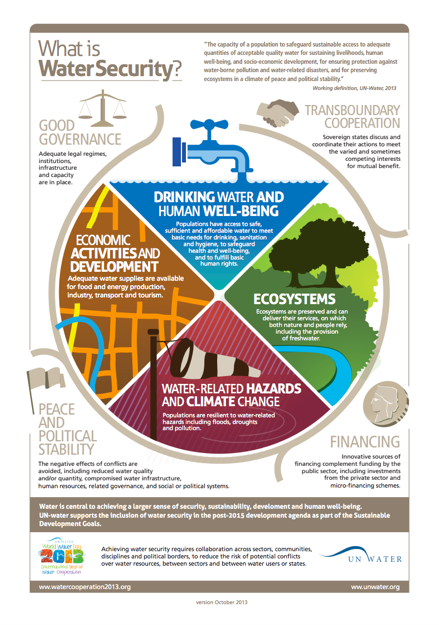
ConclusionIf we are aiming to ensure the provision of adequate water quantity and quality for today and the future, achieving water sustainability becomes crucial. The societies of today need to recognise the intrinsic value of water and its interconnectedness to human and planetary welfare. The societies of today need improved water resources management and policies to become prosperous and to be able to face an expected increase in global water demand driven by development and changing consumption patterns.
The improvement of water-related technologies and infrastructure, increasing investment and achieving water efficiency in developing countries, the development of standards to regulate and monitor water quality and ecosystem protection and the enforcement of adaptation strategies are still challenging the availability and sustainable management of water.
Water is a finite and irreplaceable resource used globally. It would be impossible to achieve water sustainability without an integrated management approach where governments, NGOs and businesses join the action and collaborate on water stewardship. The improvement of water-related technologies and infrastructure, increasing investment and achieving water efficiency in developing countries is still crucial. The development of standards to regulate and monitor water quality and ecosystem protection and the enforcement of adaptation strategies are still challenging the availability and sustainable management of water.
Please note: The SSN are working with the City of Gold Coast Water and Waste to address water security and sustainability at the 2020 Sustainability Symposium.[1]. A water system can be defined as the network where human, physical, biological and biogeochemical components interact (GWSP Framing Committee, 2004).
References
- Birkenholtz, T. (2016). Drinking water. In Eating, Drinking: Surviving (pp. 23-30). Springer, Cham.
- Biswas, A. K. (1991). Water for sustainable development in the 21st Century: a global perspective. International Journal of Water Resources Development, 7(4), 219-224.
- Bogardi, J. J., Dudgeon, D., Lawford, R., Flinkerbusch, E., Meyn, A., Pahl-Wostl, C., … & Vörösmarty, C. (2012). Water security for a planet under pressure: interconnected challenges of a changing world call for sustainable solutions. Current Opinion in Environmental Sustainability, 4(1), 35-43.
- Connor, R. (2015). The United Nations world water development report 2015: Water for a sustainable world (Vol. 1). UNESCO Publishing. Department of Economic and Social Affairs, United Nations, World Population Prospects (2019). Available from: https://population.un.org/wpp/Publications/Files/WPP2019_10KeyFindings.pdf
- Gleeson, T., Y. Wada, M. F. Bierkens & L. van Beek (2012). Water balance of global aquifers revealed by groundwater footprint. Nature, 488, 197-200.
- Graefe, O. (2016). Integrated Water Resources Management as a New Approach to Water Security. In Eating, Drinking: Surviving (pp. 43-49). Springer, Cham.International Geosphere-Biosphere Program (IGBP, 2015) Press Release, Planetary dashboard shows “Great Acceleration” in human activity since 1950. Available from: http://www.igbp.net/news/pressreleases/pressreleases/planetarydashboardshowsgreataccelerationinhumanactivitysince1950.5.950c2fa1495db7081eb42.html
- Mai-Lan Ha (2015). Acting Responsibly; Business and the Human Rights to Water and Sanitation. In Water & Sustainable Development, UN-Water, 2015. Available from: https://www.un.org/waterforlifedecade/pdf/wm-iii-eng.pdf
- Orlove, B., & Caton, S. C. (2010). Water sustainability: Anthropological approaches and prospects. Annual Review of Anthropology, 39, 401-415.
- Pahl-Wostl, C. (2007). Transitions towards adaptive management of water facing climate and global change. Water resources management, 21(1), 49-62.
- Papas, M. (2018). Supporting sustainable water management: Insights from Australia’s reform journey and future directions for the Murray–Darling Basin. Water, 10(11), 1649.
- Quevauviller, P. (2010). Water sustainability and climate change in the EU and global context–policy and research responses. In Sustainable Water (pp. 1-24). RSC Publishing.
- Russo, T., Alfredo, K., & Fisher, J. (2014). Sustainable water management in urban, agricultural, and natural systems. Water, 6(12), 3934-3956.
- Schnoor, J. L. (2010). Water sustainability in a changing world. [The 2010 Clarke Prize Lecture] National Water Research Institute, University of Iowa. 1-15.
- Steffen, W., Broadgate, W., Deutsch, L., Gaffney, O., & Ludwig, C. (2015). The trajectory of the Anthropocene: The Great Acceleration. The Anthropocene Review, 2(1), 81–98.
- Strzepek, K., Schlosser, C. A., Gueneau, A., Gao, X., Blanc, É., Fant, C., … & Jacoby, H. D. (2012). Modelling water resource systems under climate change: IGSM-WRS. MIT Joint Program on the Science and Policy of Global Change.UN-Water (2013), UN-Water Scarcity [Fact Sheet]. Water for the Decade. Available from: https://www.un.org/waterforlifedecade/scarcity.shtml
- UN-Water, (2014). A Post-2015 Global Goal for Water: Synthesis of key findings and recommendations from UN-Water.
- UN-Water, (2015). Water & Sustainable Development. Water for Life. 2005-2015
- UNDESA, (2012). Sustainable Development for the 21st Century Back to our Common Future (2012) UNDESA.
- United Nations, (1987). Our Common Future, Report of the World Commission on Environment and Development.
- UNESCO, (2014). Water in the post-2015 development agenda and sustainable development goals: discussion paper. 1-14. Available from: https://unesdoc.unesco.org/ark:/48223/pf0000228120
- Vörösmarty, C. J., Pahl-Wostl, C., Bunn, S. E., & Lawford, R. (2013). Global water, the Anthropocene and the transformation of science. Current Opinion in Environmental Sustainability, 5(6), 539-550.
- Wei, J., Wei, Y., & Western, A. (2017). Evolution of the societal value of water resources for economic development versus environmental sustainability in Australia from 1843 to 2011. Global environmental change, 42, 82-92.World Bank (2019). Population data. Available from: https://data.worldbank.org/indicator/sp.pop.totl
- WHO/UNICEF, (2014). Progress on sanitation and drinking-water – 2014 Update. World Health Organization (WHO), UNICEF. [1]. A water system can be defined as the network where human, physical, biological and biogeochemical components interact (GWSP Framing Committee, 2004).



